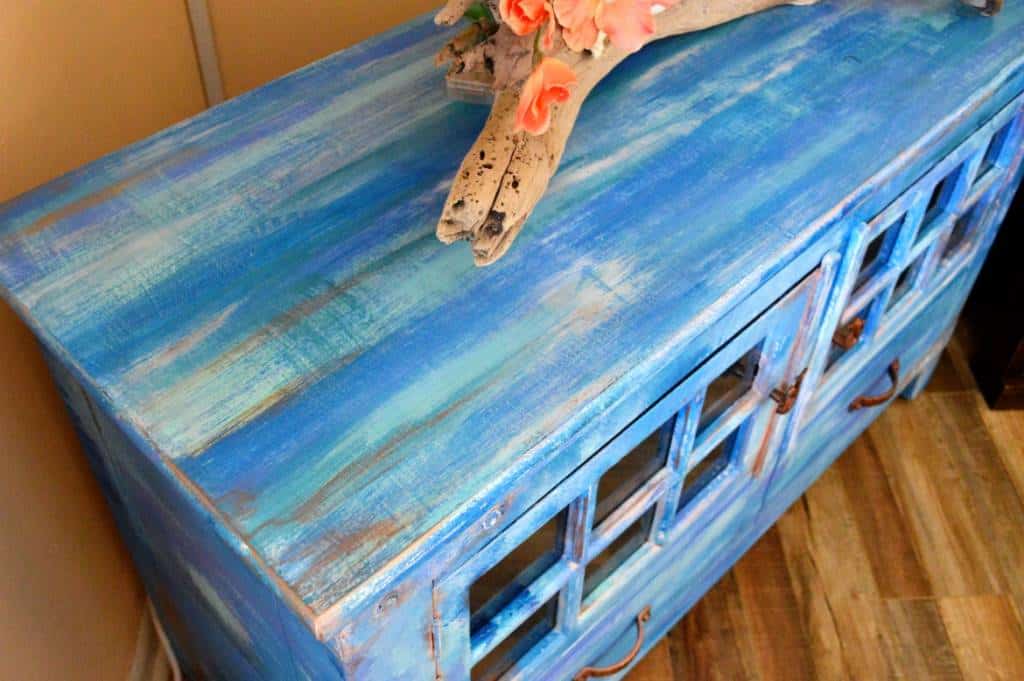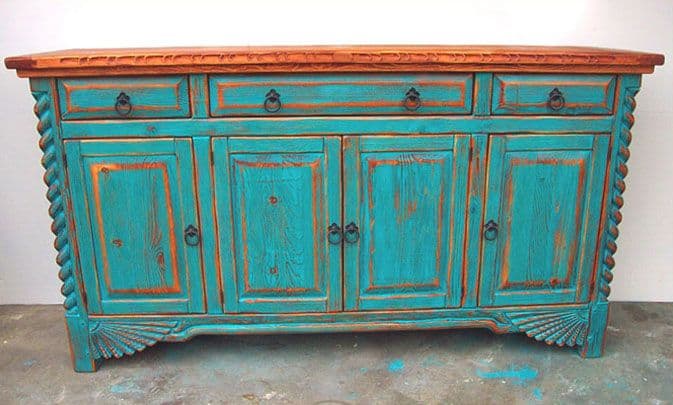New furniture designs are still coming up nowadays, but there’s nothing comparable to the feel of grandma's furniture pieces that haven’t worn out yet after years of usage and abuse. Today, however, these old, antique furniture pieces become quite expensive, so if you want to bring this warmth into your home, your best bet is to learn how to distress furniture.
What is Distressed Furniture
Distressed furniture is literally weathered or damaged to give it a look of an antique piece. Applying a patina is another way of distressing furniture and definitely one of the best things you can do to enhance a room's character and ambiance. By repurposing those pieces, such as cabinets, coffee tables and consoles, you can prevent global deforestation because the pieces are distressing wooden furniture.
Fortunately, you can use simple distressing techniques to give your wood furniture the best weathered look. When distressing furniture, you want two things: for your wood surface to show through your coat of paint, or your furniture to look like it’s been repainted several times.
So if you are ready to distress painted furniture, here are the supplies you’ll need to succeed;
- Steel wool
- Drop cloth
- Optional wood stain or polyurethane
- Candle wax
- Sandpaper
- Paint and paintbrushes
- Piece of wooden furniture
- Tack cloth
Method 1: Distressing Furniture with Paint and Sandpaper

Here are the smile steps for DIY distressing when you have a free afternoon and all the supplies above.
Step 1: Prep work
Before you start distressing furniture, you will need to protect your flooring and other features on the furniture you don’t want to distress. To be safe, though, drop some drop cloths on the floor to avoid the dust and paint debris while you work. Besides that, remove all the metallic knobs and hardware and keep them in a safe place to be reinstalled after.
Step 2: Clean and sand the entire piece
Use a dry cloth to wipe off any dirt or debris on the surface, including the top and legs. Next, unplug and grab your sanding block and begin sanding your surface.
You will also have to think about how you'll sand, as you'll need to sand or even use a paint stripper to remove some color if the piece of furniture is old or has been prime or painted several times. However, you can have a new or unfinished piece of furniture lightly sanded.
Once you’ve sanded that piece down to your liking, use the tack cloth to brush away the debris and dust. When doing this, make sure you wear protective gear so you won't inhale the elements.
Step 3: Start painting
You have three ways of painting the piece of furniture for the best results. The first way would be to use one coat of chalk paint for a matte finish and for bare wood surfaces to stick through the paint to give good distress.
You can make your furniture seem like it was already painted severally before by applying two coats of paint. You can also use wax to get the best impression of a piece of furniture painted at least twice over the years. So in this case, you want to paint the wax over just parts of the furniture, then there will be two layers of paint applied, one of which you will be able to see peeking through underneath the topcoat.
To use the wax, first you apply a base coat and rub some candle on the surface, preferably the edges and corners. Once the base coat has dried you want to apply the second color across the entire surface, even crossing the wax. The paint won’t stick to the wax so when you take the wax off you’ll get a heavily distressed look with a mix of colors.
Whichever of that distressing technique you choose, you want to make sure you paint the whole thing one time, and wait a really long time for it to dry. Your drying time can range from a few hours for a single coat of chalk paint, to overnight with multiple coats.
Step 4: Use fine-grit sandpaper to distress the piece
After the paint dries you will need to sand the piece. However, you don’t want to sand first; if you did the wax distressing you need to use a ball of steel wool before sanding. Otherwise, if you waxed the areas you can remove the wax with the steel wool until the mess is all off. Though, you don’t want to destroy the base coat with the steel wool totally.
If you did not apply two paints, you could start removing the paint using the fine-grit sandpaper, or you can also use the steel wool for extra damage. First, use the steel wool to expose bare wood on the edges and corners, then use the sanding paper to damage the flat surfaces carefully.
When you’ve reached your best shabby chic look, use a tack cloth or paper towel to clean the paint debris off with protective gear, so you don’t inhale the elements.
You can even apply a stain if you like a really distressed piece of furniture. Furnishing your house, the stain will give your furniture a more antique and therefore the focal point of your living space. Then you can apply one coat of that stain and then wipe the excess off with a soft rag or tack cloth.
Don't rub the paint in circles — this would make the distressed look obvious. However, we recommend running the brush straight and waiting for the applied stain to dry on its own.
Step 5: Seal the surface
When you are done getting the perfect look you need to use a top coat to seal the effects. In this step, polyurethane paint will do the best for you in order to get the best satin finish. Just make sure to use clear polyurethane which will seal your undercoats and you apply it to the whole surface in an even manner. After you have finished, let it dry and once dried reattach the knobs or metallic hardware you removed in step 1 above.
Here is a video to help you with these wood weathering steps:
Method 2: How to Distress Furniture By Scraping

With paint brushing and then sanding of your furniture being the easiest way for a beginner to distress furniture you can also just scrape a little paint across the surface to create a more of an older look. For this method, you will need;
- Best paint
- Putty knife
- Sanding sponge
- Paint scraper
Step 1: Prepare your workspace
Start by preparing the area by laying drop cloths so to protect your flooring. Also get rid of hardware and knobs that you don’t want to weather.
Step 2: Sand the piece of furniture
If your furniture is unfinished, lightly sanding with a sanding sponge will work. However, to damage older paints on the surface, you’ll need steel wool or more sanding power.
Step 3: Start painting
Once your surface is ready to distress, you can take the putty knife and apply your desired paint. The most authentic look you can’t get anywhere else will be provided by using a putty knife instead of a paintbrush.
First, you should scrape off a thin coat of paint and apply it unevenly across the surface and let it dry. Scrape on a second thin coat, leaving coverage to be uneven with bare wood still exposed once applied.
Note: If you want your furniture to look like it's been painted a number of times already, you can use different colors. Besides, if you are using different colors, you need to make sure each layer dries completely before adding a new color so the colors don’t blend into each other.
Step 4: Scrape off some paint
After your paint has completely dried out, it’s now time to start the process of distressing using the paint scraper. Start painting the furniture off and scrape off paint from various areas of the furniture until you get the give and desired look. When using multiple colors to let bits of color and bare wood shine through in some spots it is best to scrape layers of paint uniformly across the surface.
Step 5: Seal with a topcoat
If you want to leave your weathered furniture as is, you can. Besides, if you would like to added another coat of polyurethane paint or dark wax over the paint to seal the paint and make them more durable you can. After this step, you can also fix knobs and other parts you removed earlier, if needed.
Method 3: Distress New Furniture by Dry Brushing

The two methods above can be used on new and old furniture pieces, however, the dry brushing method is best for new pieces of the furniture you need to give a weathered look. You will only need:
- Paints
- Dry paintbrush
- Paper towels
- Drop cloth
Step 1: Prepare the work area
Before you begin, lay down the drop cloth on the floor to avoid having paint spatter and such onto it. Some fixtures you don’t want to weather can also be removed from the piece of furniture.
Step 2: Start painting
Paint your furniture with a normal coat of paint, then spread it out with another dry paintbrush. Don't forget to dry the paint out of the dry brush with the paper towels. You don’t want to get a lot of paint on your dry paintbrush, so this method is only really good if you apply very little paint.
Once you have a consistent paint spread on the surface, it will dry off before you can add in a third coat of sealant paint. It’s also possible to restore an old piece of furniture using this easy method leaving you with a slightly weathered piece.














